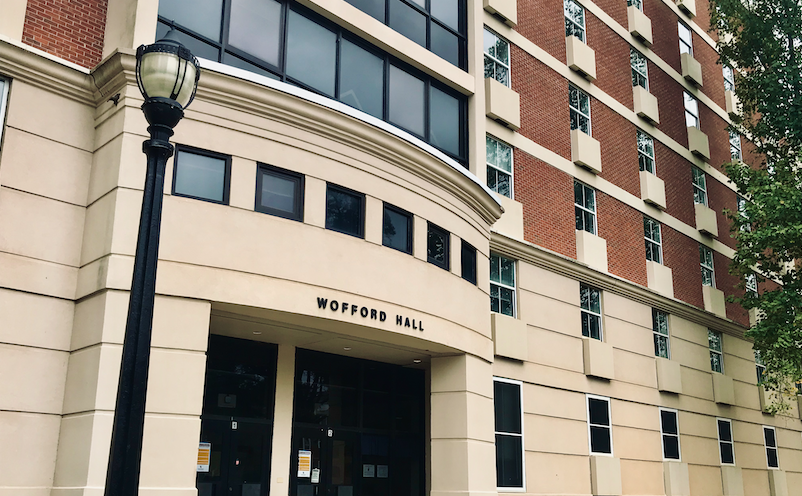In an effort to contain the potential growth of the COVID-19 pandemic amidst a university population of over 5,000 total graduate and undergraduate students, Winthrop University officials decided to set aside the Wofford Hall dormitory to house students who have contracted or are considered at high risk of contracting the virus and aren’t able to return home to isolate.
Earlier this month, The Johnsonian staff writer and senior computer science major, Philip Nelson, was placed under quarantine in Wofford Hall after his roommate tested positive for COVID-19, and was able to provide some inside information on what life is like under Winthrop’s quarantine program.
“Generally I wake up whenever I feel like waking up like normal, and I do class work like normal,” Nelson said eight days into quarantine. “I don’t leave the room at all typically, unless I’m going across the hall use the bathroom or taking a shower. I don’t really have anything I can do other than school work and I can’t leave the building, so what I’ll usually do is find things to occupy my time like reading and watching Youtube videos.”
Nelson’s quarantine journey began on Oct. 11 when he and his suitemates found out that his roommate tested positive for COVID-19. Shortly after, Nelson and one of his suitemates were determined to be exposure risks and were told they had to move into the Wofford dormitory later that day.
“I woke up around 10 a.m. on Sunday, and by around 3 p.m., I was told I needed to be moved into Wofford as soon as possible. I was told I needed to bring two weeks worth of clothes since I wouldn’t be allowed to do laundry, alongside my bedding, everything I needed for school, and personal stuff. I don’t have a car, so I had to bring everything I needed on foot from Roddey to Wofford, which is a good long haul. I didn’t even see an actual person from Winthrop that day; all of my interactions were through phone calls. They were trying to limit exposure, but there was no help getting over here or moving stuff in,” Nelson said.
Wofford is kept locked by campus police at all times, and quarantined students are only permitted to leave the building to receive medical care and testing for COVID-19. Trash bags are to be left in the hallways and are collected every Sunday and Wednesday. Students are brought food from Thompson Dining Hall between 11 a.m. and 1 p.m. for lunch and 5 p.m. and 7 p.m. for dinner, but are not given a menu to browse.
“Until I complained about it and told them they needed to bring better food, the food I got was so bad I almost didn’t eat for the first two days,” said Nelson. “On the second day, I told them to just bring me pizza or hamburgers since they were pretty much just bringing me whatever I feel like. The food has gotten better since I complained, but they’ve brought me pizza for the past five meals. They could definitely vary it a little, because I know they have better stuff in Thompson.”
“My suite mate had to pay for the food being brought because he didn’t have a meal plan, and the school told him he had to quarantine no matter what. He had no choice but to pay because he has to be here, and he can’t leave the building. It’s $14 a day for lunch and dinner from Thompson Cafeteria, which isn’t bad, but it’s not quality food.” said Nelson.
“I understand why I’m having to quarantine, but it’s not a fun experience and I think Winthrop could do a better job for its students. As of right now, it feels like prison but with the internet. Honestly, if I had been told that it was going to be this bad, I might have just not told the university that I was exposed,” Nelson said. “This is very mentally taxing, and if someone isn’t the right headspace this could really mess someone up. Not being able to leave the building for anything but medical care is really hard. I would just like to leave the building for like thirty minutes each day, but I can’t. So I end up staring at these same four walls constantly, and it’s terrible.”
Adjusting to semi-remote academic instruction amidst a pandemic already weighs heavily on the minds of college students across the country. The strenuous conditions of being socially isolated with limited dietary options and restricted mobility could have adverse effects on the mental health of international and out-of-state students who lack the ability to return home, according to Clinical Coordinator for Counselor Services, Gretchin Baldwin.
“Quarantine has been tough for humanity because humans are social creatures,” Baldwin said in an email. “In order to be healthy both physically and mentally, we need movement, light, and connection. When we are isolated in a closed space, we can miss out on those opportunities—unless we are thoughtful and intentional. Quarantine brings the potential for too much stillness, not enough light, and isolation. These are ripe conditions for a flare up of symptoms of anxiety and depression among other things.”
Public information regarding details of what quarantine on campus entails remains scarcely available to students. The Return to Learn website, an online guide Winthrop designed to inform students about updates and changes relating to COVID-19, makes no mention of Wofford Hall or provides any details on the quarantining process for students unable to return to home other than stating that the process for them exists. According to Interim Director for Residence Life, Howard Seidler,
this decision was born out of lack of necessity.
“I don’t know if we’ve publicized that information necessarily. If a student needs to be quarantined or isolated, they need to leave campus. If they don’t have a place to go or if they live far away and can’t get home, that’s when we house students for quarantine and isolation. I don’t know that it was publicized or put on the website, it wasn’t really necessary to do that,” Seidler said.
Seidler went on to state that the Wofford dormitory has only housed 2-3 quarantined students at a time during this semester. According to Winthrop Registrar Gina Jones, the university currently houses 816 out-of-state undergraduate and graduate students, 85 of which have come from other countries. As of Oct. 25, Winthrop’s COVID-19 Dashboard has recorded 40 cumulative positive cases since March 16.
Photo by Emma Crouch




